In addition to the postal markings in other sections the following
have some relationship to the Society of Jesus:
Jesuit
Missions
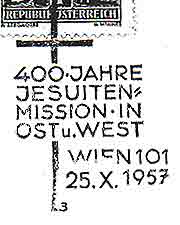
AUSTRIA, 1957, cancel celebrating 400 years of Jesuit missions, East
and West
Bicentenary
of the Restoration

ITALY, 2014, cancel celebrating the bicentenary of the Restoration
The
Spiritual Exercises
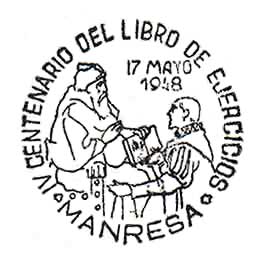
SPAIN, 1948, 4th centenary of the Spiritual Exercises by Pope Paul
III
After his vigil of arms at Montserrat Ignatius spent
almost a year in the town of Manresa, Spain, praying, doing penance,
serving the poor, and making notes that would develop into the Spiritual
Exercises, the basis of Jesuit spirituality and the retreat movement
around the world. By the end of his studies in Paris (1535) it was basically
finished, except for some minor changes. But in 1548 the book of the Spiritual Exercises was formally approved by Pope Paul III.
SJ
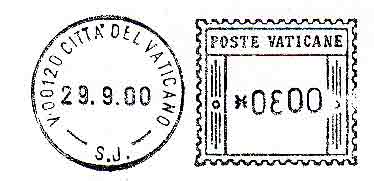
VATICAN CITY, 2000, meter stamp with an "S.J."
Jesuit
Related Place Names
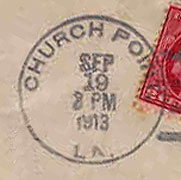
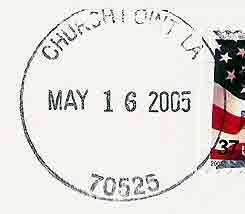
UNITED STATES OF AMERICA, 1913, postmark from Church Point, Louisiana
UNITED STATES OF AMERICA, 2005, postmark from Church Point, Louisiana
By the 1848, there were enough residents on Bayou Plaquemine
in Louisiana for Jesuit missionaries to construct a mission chapel here
on land donated by the Daigle brothers. They had been coming for some time to offer
Mass in a private home. The church was known as La Chapelle de la pointe de Plaquemine Brûlé (in English, "The Church at the point of Burnt Persimmon"), later shortened in English
to "Church Point" to refer to the spire on top of the church which could be seen, and traversed to, for miles in this frontier area, and translated back into French as La Pointe de l'Eglise. The first post office here (1873) was consequently
named Church Point, Louisiana, and the town was incorporated in 1899 under
the same name.
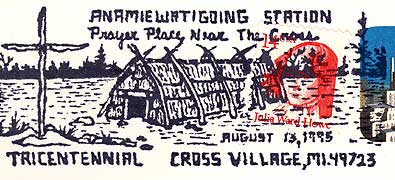
UNITED STATES OF AMERICA, 1995, special cancel for the tricentennial
of Cross Village, Michigan
Cross Village is one of the oldest settlements in Michigan
and today is known for its ties to the Native American Ottawa tribe. As
late as 1787, as many as twenty tribes populated the region and met here
around tribal council fires. Jesuits came here in the early 1600s and
Father Jacques Marquette is said to have planted the original huge white
cross on the bluff overlooking Lake Michigan before his death in 1675.
Today, a replica of his cross stands at the edge of the bluff and is visible
from far off shore. The Native Americans called the village Anamiewatigoing
(At the Tree of Prayer, or Cross). The name La Croix (The Cross) was used
from 1847 to 1875 when it was changed to Cross Village.

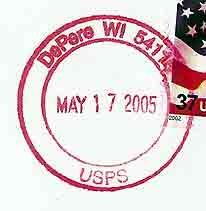
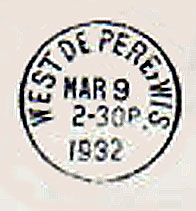
UNITED STATES OF AMERICA, precancel from De Pere, Wisconsin
UNITED STATES OF AMERICA, 2005, postmark from De Pere, Wisconsin
UNITED STATES OF AMERICA, 1932, postmark from West De Pere, Wisconsin
Father Claude
Allouez, SJ, around 1670 opened a chapel dedicated to St. Francis
Xavier in an Indian village where today stands the town of De Pere,
Wisconsin. The town supposedly takes its name from the nearby cataracts
on the Fox River called the Rapides des Peres (Rapids of the
Fathers), although the former name of the town was Père Marquette.

UNITED STATES OF AMERICA, 1942, postmark from Holy Cross, Territory
of Alaska
The name "Holy Cross" was given to this church
and mission by its Jesuit founder, Fr. Aloysius Robaut, SJ. It was founded
in 1888 and is located 279 miles upriver from the Bering Sea on the
right bank of the Yukon River. Holy Cross's long Catholic history began with
a little two-story log-cabin mission, originally intended as a Jesuit
house, but soon the cabin became a convent, and the convent a boarding
school. By the time the boarding school closed in 1956, some 95 Jesuits
had served on this mission.
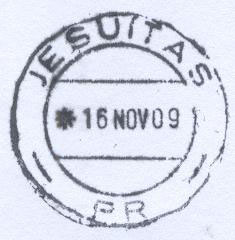
BRAZIL, 2009 postmark for Jesuitas in the Brazilian state of
Paraná.
Jesuitas is a city in the Brazilian state of Paraná.
The first pioneers to arrive in the city region came in 1959 and 1960
in search of in timber and agricultural cultivation. The name was given
to the city in honor of Jesuit priests who evangelized the Indians who
lived here. Coffee plantations are the economic mainstay of the city,
with more than 10 million trees planted.
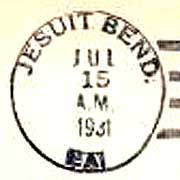
UNITED STATES OF AMERICA, 1931, postmark from Jesuit Bend, Louisiana
Jesuit Bend is an unincorporated community in Plaquemines Parish, Louisiana, United States, on the West Bank of the Mississippi River. Members of the Society of Jesus settled at this location in the early part of the 18th century, a bend in the Mississippi River, hence the name "Jesuit Bend". The Jesuit settlers brought with them from Asia the satsuma, a loosely skinned seedless tangerine. Satsumas have been farmed at this locale ever since. Jesuit Bend was also the site of an incident in 1955 when Rev. Gerald Lewis, an African-American Catholic priest, was stopped by parishioners from celebrating Mass there because of his color. The community was thereupon placed under interdict by the Archbishop of New Orleans, Joseph Francis Rummel.
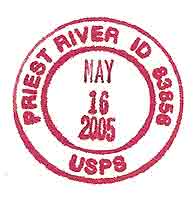
UNITED STATES OF AMERICA, 2005, postmark from Priest River, Idaho
Priest River, Idaho (the town), and the nearby Priest River (the river)
and Priest Lake are related. Fr. Peter De Smet in 1846 christened the
lake Roothan Lake to honor his Jesuit superior general. A nearby mountain
still bears the name Roothan. The lake was later Priest Lake, honoring
Jesuit missionaries in general rather than the one Jesuit General. The
name of river and town followed suit.
NEXT













